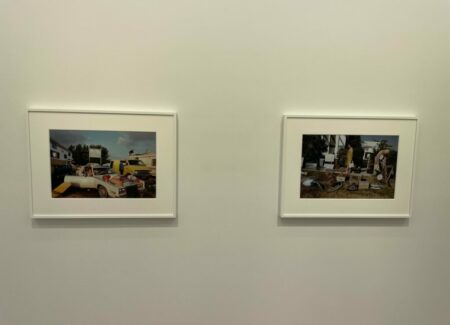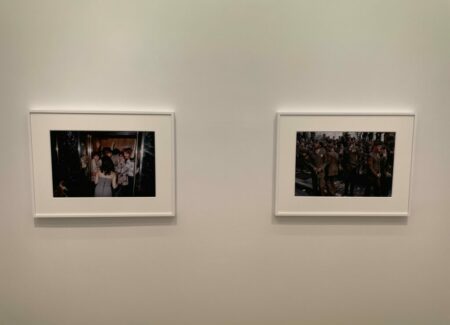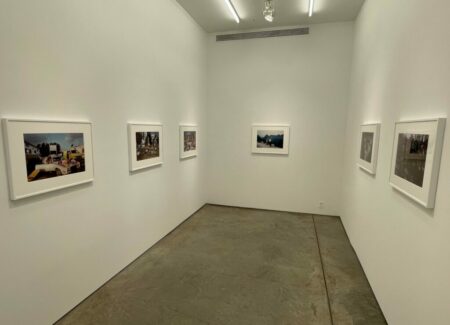JTF (just the facts): A total of 8 color photographs, framed in white and matted, and hung against white walls in the smaller project gallery. All of the works are chromogenic prints, made between 1973 and 1983. Each print is sized 14×21 inches, and is available in an edition of 10. (Installation shots below.)
A monograph of this body of work was published in 2022 by Steidl (here), as an expanded reprint of the original 2005 edition.
Comments/Context: My initial reaction to this small show of Mitch Epstein’s color photographs from the 1970s and early 1980s was wow, back then he was really packing his frames. With the exception of two pictures (one of a couple dancing and another of a different couple looking through binoculars), all of the photographs in this single room are astonishingly busy with activity – they aren’t “decisive moments” so much as elaborate tableaux where multiple decisive moments are happening simultaneously in close proximity. There is so much going on in these pictures, and so much resonant detail to be found, that they feel almost surreal, like the kind of pictures a contemporary photographer would have meticulously staged to get all the actions and reactions (and reactions to reactions) perfectly synchronized. But of course, Epstein discovered these moments “in the wild” and visually organized them with an eye for telling energetically layered single frame stories.
These images come from Epstein’s early days, and were gathered together as a body of work called “Recreation”, in book form in 2005, and then in an expanded version again last year. And in many ways, they are a real throwback, in that Epstein doesn’t really make pictures like these any more, and hasn’t for several decades. In recent gallery shows, in 2019 (reviewed here) and 2016 (reviewed here), and even before that, Epstein’s vision has been much slower and more controlled, paying close attention to portraits, landscapes, and singular events, and even spending time patiently observing rocks, clouds, and trees. The images in this show were made almost in a different artistic lifetime, in his twenties and early thirties, at a moment in photography when color was new and the vantage point of the handheld camera (like that of Garry Winogrand, his teacher at Cooper Union) was much more fluid and improvisational.
An image from Cocoa Beach, Florida, in the early 1980s takes a crowded parking area as its setting. A white car in the center anchors the composition, with the side door open and a woman caught waving (or perhaps just getting out) in the afternoon sun; two kids are resting on the expansive hood of the car, and a box of doughnuts sits above the woman’s head on the roof of the car. All of this might have been enough for a successful picture, but there’s plenty more nearby – a man talking into the passenger window of a yellow van parked next door; a couple on the roof of their RV another spot over, with the older man climbing up the ladder; the back of a white sign and more jammed in cars in the background; and a yellow plastic lounge chair jutting in from the lower left. The image has echoes of color, of angles, of open doors, and a range of gestures taking place all at once, the swirling chaos of normalcy seemingly going unnoticed.
This same kind of everyday whirlwind takes place in a mid 1970s beach scene at Jacob Riis Park in Queens. Like any New York beach in the summer, it’s overstuffed, with people jammed together on seemingly every available inch of sand. The main action in Epstein’s picture is taking place on the right side of the frame, where three guys are goofing around – one is standing, placing his hand on top his sitting friend’s head, while the third friend puts his hand up between the standing man’s legs. It’s a slapstick comedy kind of moment, and one couple nearby watches, as do a few other people off to the right. But Epstein doesn’t zero in on this moment entirely; he allows the rest of the beach activity to surround this action. In the foreground, two guys lie talking to each other, while a girl next to them reads. To the left, a man sits on top of his partner, applying sunscreen or massaging, and the background falls into a dense all-over pattern of faces and bodies, with a single beach umbrella interrupting the sea of humanity. Seen as one synchronized moment, it is both playfully funny and a slice of life, like a non-linear narrative weaving half a dozen seemingly unrelated strands into one story.
While photography is of course a silent medium, the boisterous whoops and hollers coming from Epstein’s image of a crowded Dallas elevator (from 1974) are nearly audible. Here the catalyzing event is the arrival of a young woman who tries to jam into the full elevator car; inside, several obviously hammered men in 70s era patterned shirts could hardly be more excited to see her. Between raucously laughing and taking slugs from their Schlitz and Coors cans, they make a little room, pushing back against a sea of less identifiable elevator passengers and party goers, several with their hands extended above their heads in emphatic rock concert gestures. It’s a gloriously effusive moment, filled with overflowing energy, with half a dozen reactions taking place all at once; there’s even one disembodied arm reaching around the side to hold the door open for her.
The other three images on view offer similarly dense arrangements of singular moments. Epstein takes in a gathering of soldiers hanging around watching a Vietnam war parade in New York City, with various dapper men having a smoke or looking around with the curiosity of men about town. He watches people browse the eclectic offerings at a yard sale in Los Angeles – including a vacuum, a fan, a groovy clock, a standing lamp, and something called an infra red defroster – with one older man carrying a paper bag and bent over, as if resting or examining the nearby sawhorse. And Epstein examines a gathering of acrobats in Santa Monica, with one being launched into the air from a springboard, another waiting expectantly to catch her, and several more taking note, milling around, or getting ready, the composition filled with people looking in different directions. In each picture, there are half a dozen side stories waiting to be told, with various hints and details offered as tantalizing visual enticements.
It’s interesting to think about how much serendipity and spontaneity fills these images, and how Epstein ultimately moved away from this working style as he developed and refined his artistic voice. It’s also intriguing to see how these pictures have been positioned: as visions of 20th century America, and more generally as scenes of recreation or leisure, as if their content or subject matter was the important thing. From my vantage point, the strongest of these images thrums with a kind of aesthetic vitality that is hard to replicate, the cacophony of movement harnessed for just a split second into something approaching elegance – it’s not the content that matters at all, it’s the way the Epstein has seen and arranged that energy. Sure, these photographs are a time capsule of a bygone age, but what we should value in them is their construction. There’s a reason these pictures still feel so fresh and engaging, and it’s clearly not their 1970s era looks and fashions; underneath that patina is something smartly structural, where multiple linked narratives are encouraged to interact and fill the available space. Novelists and film directors have long embraced such kinds of collapsed and layered narrative forms – even if he didn’t entirely realize it at the time, Epstein was pulling on some of these same threads photographically.
Collector’s POV: The prints in this show are priced at $11500 each. Epstein’s work has become more available in the secondary markets in past few years, but the volume of prints for sale has still been relatively small, with prices ranging between $2000 and $63000.









